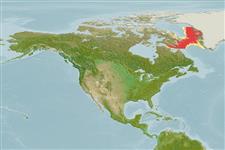Common names from other countries
Environment: milieu / climate zone / depth range / distribution range
Ecología
marino batidemersal; rango de profundidad 39 - 1200 m (Ref. 117245), usually 71 - ? m (Ref. 117245). Deep-water; 0°C - 5°C (Ref. 35388); 74°N - 61°N, 72°W - 45°W (Ref. 117245)
Arctic to Northwest Atlantic: Canada to Greenland.
Tamaño / Peso / Age
Maturity: Lm ? range ? - ? cm
Max length : 52.0 cm TL macho / no sexado; (Ref. 4695); common length : 27.5 cm TL macho / no sexado; (Ref. 4695)
Dorsal fin without depression, front end with 0-3 black - brown spots. Lateral line runs near the anal fin (Ref. 35388).
Lives at temperature of 0-5°C. Off Greenland it measures 50 cm and off Scandinavia rarely over 25-30 cm (Ref. 35388). Benthic (Ref. 58426). Feeds mostly on endobenthic prey, with shrimps and euphausiids becoming the more prominent prey as the size increases (Ref. 13532). Prefers warmer waters (Ref. 13534). Large eggs of 6 mm diameter are deposited on the sea floor.
Life cycle and mating behavior
Maturities | Reproducción | Spawnings | Egg(s) | Fecundities | Larva
Anderson, M.E., 1994. Systematics and osteology of the Zoarcidae (Teleostei: Perciformes). Ichthyol. Bull. J.L.B. Smith Inst. Ichthyol. 60:120 p. (Ref. 11954)
IUCN Red List Status (Ref. 130435)
CITES (Ref. 128078)
Not Evaluated
Threat to humans
Harmless
Human uses
Pesquerías: pesquerías de subsistencia
Herramientas
Special reports
Download XML
Fuentes de Internet
Estimates based on models
Preferred temperature (Ref.
115969): 1.4 - 5.6, mean 3.2 (based on 263 cells).
Phylogenetic diversity index (Ref.
82804): PD
50 = 0.5000 [Uniqueness, from 0.5 = low to 2.0 = high].
Bayesian length-weight: a=0.00219 (0.00137 - 0.00348), b=3.18 (3.04 - 3.32), in cm Total Length, based on LWR estimates for this species & (Sub)family-body (Ref.
93245).
Nivel trófico (Ref.
69278): 3.4 ±0.42 se; based on food items.
Resiliencia (Ref.
120179): Muy bajo, población duplicada en un tiempo mínimo superior a 14 años (Preliminary K or Fecundity.).
Fishing Vulnerability (Ref.
59153): Moderate vulnerability (41 of 100).
